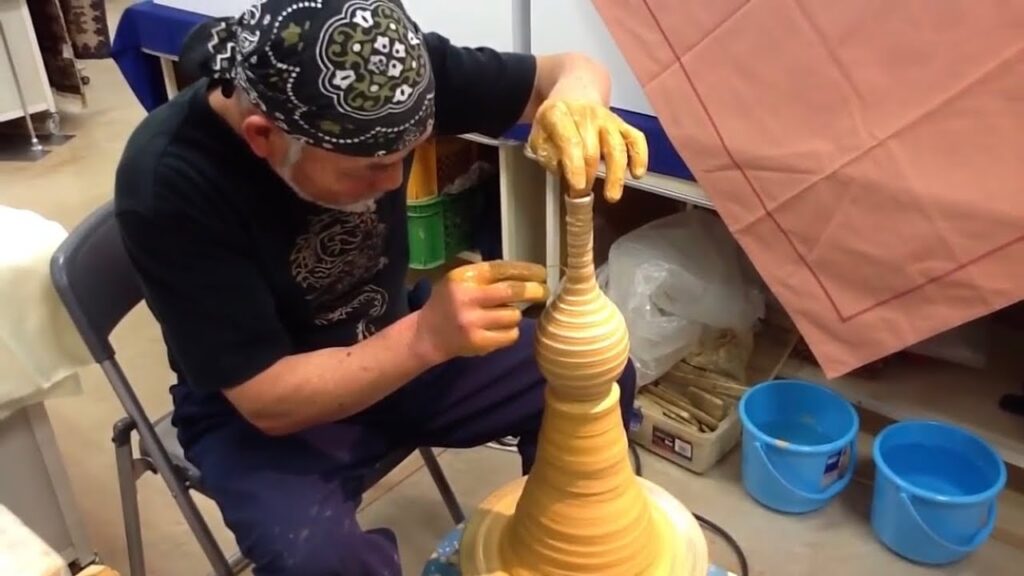Pottery and porcelain (陶磁器, tōjiki, also 焼きもの yakimono, or 陶芸 tōgei), is one of the oldest Japanese crafts and art forms, dating back to the Neolithic period. Kilns have produced earthenware, pottery, stoneware, glazed pottery, glazed stoneware, porcelain, and blue-and-white ware. Japan has an exceptionally long and successful history of ceramic production. Earthenwares were created as early as the Jōmon period (10,500–300 BC), giving Japan one of the oldest ceramic traditions in the world. Japan is further distinguished by the unusual esteem that ceramics holds within its artistic tradition, owing to the enduring popularity of the tea ceremony.
Japanese ceramic history records distinguished many potter names, and some were artist-potters, e.g. Hon'ami Kōetsu, Ogata Kenzan, and Aoki Mokubei. Japanese anagama kilns also have flourished through the ages, and their influence weighs with that of the potters. Another characteristically Japanese aspect of the art is the continuing popularity of unglazed high-fired stoneware even after porcelain became popular. Since the 4th century, Japanese ceramics have often been influenced by Chinese and Korean pottery. Japan transformed and translated the Chinese and Korean prototypes into a uniquely Japanese creation, and the result was distinctly Japanese in character. Since the mid-17th century when Japan started to industrialize, high-quality standard wares produced in factories became popular exports to Europe. In the 20th century, a modern ceramics industry (e.g., Noritake and Toto Ltd.) grew up.
Japanese pottery is distinguished by two polarised aesthetic traditions. On the one hand, there is a tradition of very simple and roughly finished pottery, mostly in earthenware and using a muted palette of earth colours. This relates to Zen Buddhism and many of the greatest masters were priests, especially in early periods. Many pieces are also related to the Japanese tea ceremony and embody the aesthetic principles of wabi-sabi ("austerity-rust/patina"). Most raku ware, where the final decoration is partly random, is in this tradition.The other tradition is of highly finished and brightly coloured factory wares, mostly in porcelain, with complex and balanced decoration, which develops Chinese porcelain styles in a distinct way. A third tradition, of simple but perfectly formed and glazed stonewares, also relates more closely to both Chinese and Korean traditions. In the 16th century, a number of styles of traditional utilitarian rustic wares then in production became admired for their simplicity, and their forms have often been kept in production to the present day for a collectors market.
Latest Uploads:
🌍Check my website / blog:
📸Add me on Instagram:
🐦Add me on Twitter:
📕Add me on Facebook:


this man is really amazing, he has devoted his life to perfecting pottery and that has brought him nothing but success and happiness
As a beginner pottery student, I marvel at this extreme level of skill. Truly a master of his craft.
prove it … all we know is some guuy makes some pottery … WHAT he is saying is IMPORTANT … the music destroyed any useful commentary and destroyed all credibility of the potter because they deemed his words not more important than the music … so if the background noise is loud WRITE IT DOWN ON SCREEN … no words no worth
stunning! Wish someone would do a “talk-through”.
i actually like the music but that’s probably because i wasn’t watching to learn, i was watching because pottery looks calming. great pottery sir!
+nav kour
In the beginning, it’s anything but calming.
Once you get some control of the clay, yes. With the benefit of making all sorts of things that are useful as well as attractive.
Depending on the clay body, you can make kitchenware, planters, tiles, statuary–even the space shuttle had ceramic tiles glued on the outside to be a heat shield.
would love to see the finished pieces after the firing and glazing is completed. i’ll bet that bowl is one amazing looking piece!
+dru “druboy” boy yes
FatCowWithAids n
FatCowWithAids ll
I went out with a Japanese master potter for over a year. She was a magician, and left me with a few (what I consider) priceless pieces. I love that the Japanese revere their master crafts people, and Kumagae San’s skill at the wheel is amazing. As to the music/voice comments: the light in his eyes and his smile was enough, and Liszt is good enough for me.
I love watching pottery appear out of a lump of clay, thanks for posting.
Also I love this piece of music you’ve chosen, what’s the conductor and orchestra? I haven’t heard it played with such an emphasis on brass instruments
Very clever! I’m impressed at your ingenuity! As a potter tho, you have to have good speed control to be able to throw effectively but the bigger issue is it has to have enough torque to handle both the weight of the clay or the pressure from bearing down on it, especially during centering.
Wonderful work! Steady hand with such strength and beauty that is mastered.
Very entertaining and beautiful work. Thank you for sharing this with us!
Poetry in motion. This man is a wizard. He is absolutely mesmerizing to watch.
I love how his narrow-necked vase looked at 9:46 – it didn’t show it but I assume he painted it with slip just before that? What an interesting technique to use that looped wire like that. He is definitely a master potter – I understand that the background noise didn’t allow his voice to be recorded clearly, but a few subtitles here and there would have been helpful.
What a privilege to watch a master work. He is amazing.
WOW! That is absolutely stunning!😲💕
Maravilhoso!
I love his work and he looks like he is enjoying himself! Cheers Bob 🇬🇧
Muito lindas!👏
Me parece magistral, un mago con arcilla en las manos moldeando fantasías o caprichos. Qué oficio tan antiguo, pero, a la vez, moderno y eterno: nunca morirá este hacer. Le felicito por su maestría, gracias por la exposición.
👍 🇪🇸
His smile and that gleam in his eyes are enough to impart magic on anything he touches.
never seen this way of making pottery before
super cool method